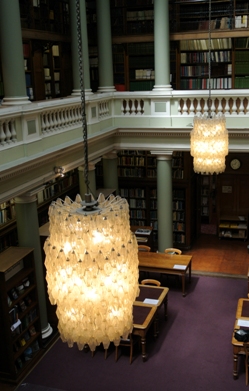Enlightenment hits library
 Visitors to the Library often ask about our chandeliers, but until now we have not been able to tell them much, writes Caroline Lam.
Visitors to the Library often ask about our chandeliers, but until now we have not been able to tell them much, writes Caroline Lam.
Archive research has replaced rumour and speculation, revealing that the lights were installed during a major refurbishment of the apartments between 1969 and 1974. This makeover was precipitated by the removal of the Royal Society to Carlton House Terrace in 1967, when the remaining societies shifted around or acquired new rooms. We, for instance, gained the old Meeting Room of the now defunct ‘Society of Chemists’. The room was split in two and now forms the Lyell and Map Rooms.
The chandeliers were bought in October 1971 - those in the Library for £300 each and the smaller one in the Fellows Room for £200 (c. £15,000 in today’s prices, in total). Both were made by Venini. The Venini company was established in 1921 in Murano, centre of glassmaking in Venice, as a partnership between the Venetian antiques dealer Giacomo Cappelin and the Milanese lawyer Paolo Venini, whose family had a long history of working in glass. By the mid 20th Century the firm had established itself as a leader in modernist design, their master glassblowers collaborating with different artists to create the best in art glass – from tableware right through to large architectural sculptures.
The polyhedral forms (produced by hand blowing glass into moulds) were designed by architect Carlo Scarpa (1906-1978) and exhibited in 1961 at Expo Italia in Milan. Scarpa produced a range of designs using these faceted shapes for Venini, for whom he had previously been artistic director (1932-1947).
The Society received a photograph of a typical Scarpa chandelier with a diagram of two designs in September 1971, but they were still hesitant – the cost exceeded the entire electrical budget by £50! Three Officers visited to the (now vanished) Royal Bank of Scotland branch, Regent Street, to see one in situ and were even treated to a mock up of the larger model in the Library before deciding to buy.
So, love them or hate them, our chandeliers are now firmly established as ‘mid-century classics’.